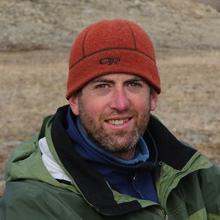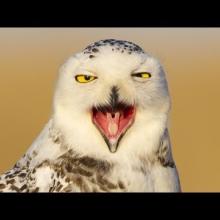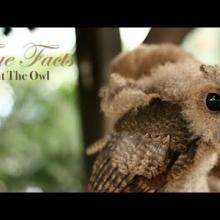

Join BirdNote tomorrow, November 30th!
Illustrator David Sibley and actor H. Jon Benjamin will face off in the bird illustration battle of the century during BirdNote's Year-end Celebration and Auction!
In some years, great numbers of Snowy Owls come south from the Arctic to reside in fields, farmlands, and shorelines. In the past, it was believed that population crashes of lemmings on the breeding grounds caused many owls to come south. But their movements are more complex and unpredictable than that. The years that we see many Snowy Owls actually seem to be the result of an abundance of lemmings on the breeding grounds and thus, throngs of hungry young owls. Be sure to watch the video by Gerrit Vyn.
BirdNote®
Snowy Owls Are Here
Written and narrated by Gerrit Vyn
This is BirdNote.
[Punctuation of male Snowy Owl hooting]
Snowy Owls are a mystery in many ways. In some years great numbers come south from the Arctic to reside in fields, farmlands and shorelines. In other years we see very few. People have long wondered where they come from and why.
In the past it was believed that population crashes of lemmings on the breeding grounds caused many owls to come south. But their movements are more complex and unpredictable than that – they are affected by weather, availability of prey and breeding success. The years that we see many owls in the south actually seem to be the result of an abundance of lemmings on the breeding grounds. [nestlings] This owl food can lead to fantastic breeding success and throngs of hungry young owls. [nest calls] Many may be driven southward by competition with more dominant adult owls. [male alarm call] [music]
Each nomadic owl is on a lifelong journey spanning continents in search of food.
Individuals have been tracked moving from Alaska to the Canadian Arctic to Russia over the course of a just a couple of years. Some wander the pack ice, hundreds of miles of from land where they feed in Arctic darkness on seabirds that they snatch from the water with their hooked talons. [adult screeching]
When one of these arctic wanderers comes south to reside in a farmer’s field, we get to glimpse a moment in a long journey that we as humans can hardly imagine.
For BirdNote, I’m Gerrit Vyn. To see these owls on video, come to birdnote.org.
###
Sounds of Snowy Owls provided by The Macaulay Library at the Cornell Lab of Ornithology, Ithaca, New York. Male hooting [138288] recorded by Gerrit Vyn, hatchling sounds [54811] by Martha Fischer; male alarm call [138288] by Gerrit Vyn; adult screech [137339] by Philip S. Taylor.
Music played by J. Kessler
Producer: John Kessler
Executive Producer: Chris Peterson
© 2015 Tune In to Nature.org February 2015 / 2021 Narrator: Gerrit Vyn
ID# SNOW-vyng-01-2012-02-03





